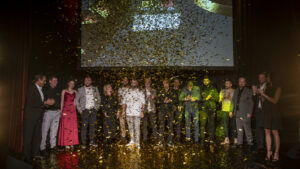
Status statt Nachhaltigkeit: So tickt Gen Z beim Auto
Eine repräsentative Umfrage des Forschungsinstituts TX Group Market Research im Auftrag von AutoScout24 zeigt, wie die Generation Z (18–29 Jahre) zum Auto steht. Eigenes Auto

Eine repräsentative Umfrage des Forschungsinstituts TX Group Market Research im Auftrag von AutoScout24 zeigt, wie die Generation Z (18–29 Jahre) zum Auto steht. Eigenes Auto

Im ersten Quartal verzeichnete AutoScout24 einen Preisrückgang bei Elektroautos, während die Preise im Gesamtmarkt stabil blieben. Fahrzeuge verkauften sich schneller als zuvor: besonders mit alternativen

Auf AutoScout24 hat sich die Nachfrage nach der chinesischen Automarke BYD innerhalb eines Jahres vervierfacht. Während deutsche Hersteller mit schwankender Nachfrage konfrontiert sind, gewinnen chinesische

Mit den ersten Frühlingstagen zieht es wieder mehr Schweizerinnen und Schweizer in die Natur. Und das zeigt sich auch auf AutoScout24: Die Nachfrage nach Campingfahrzeugen

Tesla verliert an Schwung auf dem Gebrauchtwagenmarkt. Während immer mehr Elektroautos auf AutoScout24 inseriert werden, nimmt die Zahl der Tesla-Angebote ab. Weniger Inserate, schwankende Nachfrage

Eine repräsentative Umfrage des Forschungsinstituts YouGov im Auftrag von AutoScout24 gibt Einblicke in die Einstellung der Schweizer Bevölkerung zu Elektroautos. Obwohl Elektrofahrzeuge im Jahr 2024

Die Anzahl der Neuzulassungen für reine Elektrofahrzeuge sank im Jahr 2024 um 12,7 %, während das Angebot auf dem Occasionsmarkt bei AutoScout24 stabil blieb. Ein

Am Mittwoch, 20. November, verwandelte sich das Kaufleuten Zürich zum Treffpunkt der Schweizer Automobilbranche. Über 200 Gäste kamen zusammen, um die erstmalige Verleihung der AutoScout24

AutoScout24 beeindruckte an der diesjährigen Auto Zürich vom 6. bis 10. November mit einem erfrischenden Auftritt und dem KI-gesteuerten Hologramm „Mike“. Der interaktive EV-Experte beantwortete

Der hohe Anteil an SUVs auf AutoScout24 verdeutlicht: Die Fahrzeugkategorie ist bei den Schweizer:innen nach wie vor beliebt. Gleichzeitig steigt das Interesse an umweltfreundlichen Antrieben
SMG Swiss Marketplace Group AG gibt ihren Kundinnen und Kunden die besten Tools für ihre Lebensentscheidungen an die Hand. Das Portfolio umfasst Real Estate (ImmoScout24, Homegate, Flatfox, alle-immobilien.ch, Immostreet.ch, home.ch, Publimmo, Acheter-Louer.ch, CASASOFT, IAZI), Automotive (AutoScout24, MotoScout24), General Marketplaces (anibis.ch, tutti.ch, Ricardo) und Finance and Insurance (FinanceScout24, moneyland.ch). Das Unternehmen wurde im November 2021 von TX Group AG, Ringier AG, Die Mobiliar und General Atlantic gegründet.
Head of Design for Automotive
Introduce yourself and your role at SMG
I’m Marta Andreoni, Head of Design at SMG Automotive. I lead the design and UX writing team shaping AutoScout24 user experience.
In my role, I wear many hats. My main focus is ensuring we stay true to our vision “simplifying people’s lives and connecting humans through innovative digital platforms” and our brand promise, “make it happen”. I challenge my team to think user-first, push for innovation, ease of use for our customers and make forward-thinking decisions, even within business and technological constraints.
A big part of my role is supporting each designer’s growth, motivation, and career development. Through one-on-one coaching, mentoring, group work, and projects, I help my colleagues set and achieve their goals while fostering new learning opportunities.
What helps you feel empowered and confident in your role?
If I had to mention one thing I would say “being proactive” has been key to feeling more empowered. I enjoy solving problems, so when issues or opportunities arise, be it in the product, market or the team, I get curious and I proactively investigate the reasons and try to bring inputs to be discussed with others, this makes me feel I can be part of the process or solution and my point of view is going to be taken seriously. My optimism also plays a role, giving me confidence that even the most complex challenges can be solved.
Besides, having trust from other managers and colleagues makes me feel in a safe environment where I can take ownership on topics I’m passionate about.
What’s one thing SMG does well in fostering an inclusive workplace? What more can be done to amplify and support different perspectives in the workplace?
In my experience, we strive for balancing top-down and bottom-up inputs, ensuring employees can influence product directions, processes, and culture. People are approachable, and our strong feedback culture helps voices be heard. Across SMG, initiatives like regular People & Culture Surveys, topic guilds, and events in our locations across the world foster open exchange and mutual learning.
That said, I’ve noticed that quieter voices sometimes get less space, or interacting with top management can feel intimidating, especially when giving critical feedback. To make participation more inclusive, we could apply more facilitation and group work techniques like structured turn-taking, written input, and smaller group discussions – ensuring everyone, regardless of confidence level, seniority or personality, feels comfortable contributing.
Design is often about seeing the world differently. How do unique perspectives contribute to more innovative, inclusive, or impactful design?
Design is about understanding diverse user personas and perspectives to create solutions that truly meet their needs or create new opportunities. I believe in the power of collaboration to shape user experiences – bringing together different disciplines, backgrounds, and lived experiences helps challenge assumptions, uncover blind spots, and drive more inclusive, innovative, and impactful solutions.
Looking back on your career, what’s one lesson or piece of advice you wish you had known earlier as a leader in design?
There are three things no one really prepares you for as a design leader: dealing with constant change, facing failure and handling emotions at work. These topics aren’t talked about much until you face them. I was lucky to learn from others’ experiences, but much of it came through my own.
One thing I wish I had understood earlier is the power of emotional intelligence, my job is no longer about the content and the design, it is about people. Self-awareness, not just of your own emotions, but also how others feel and react, can be the difference between conflict and harmony, frustration and clarity. The more I grow as a leader and designer, the more I realise that design isn’t just about doing the design job, delivering solutions on the market: it’s about navigating people, their emotions, and making change more acceptable and transforming issues into opportunities, both within the organisation and through great products.